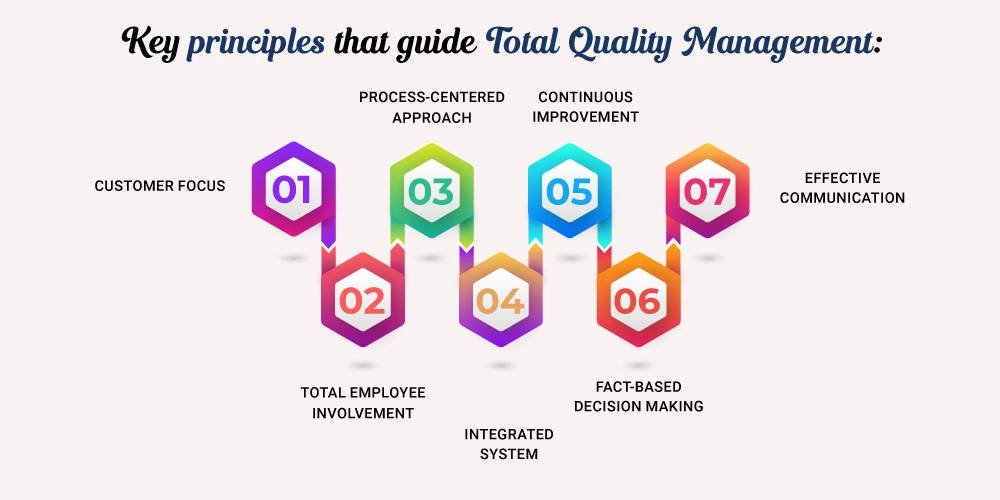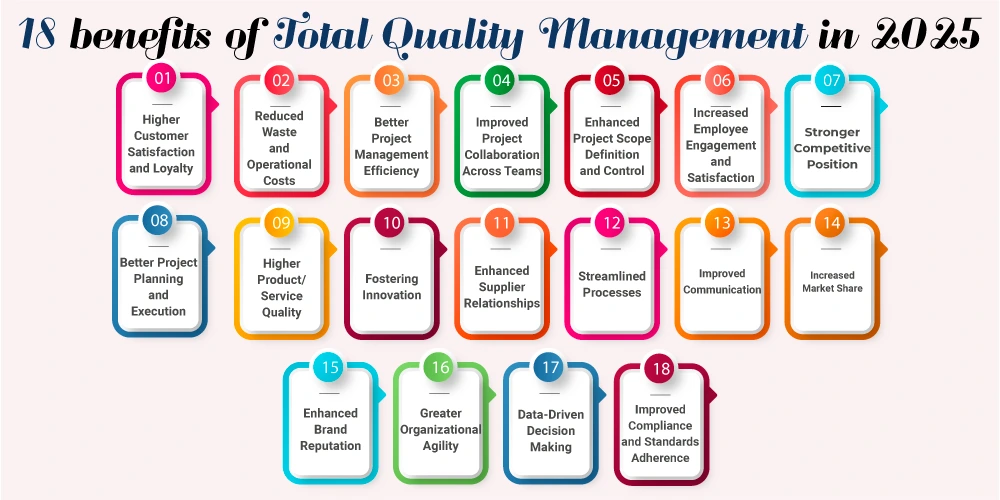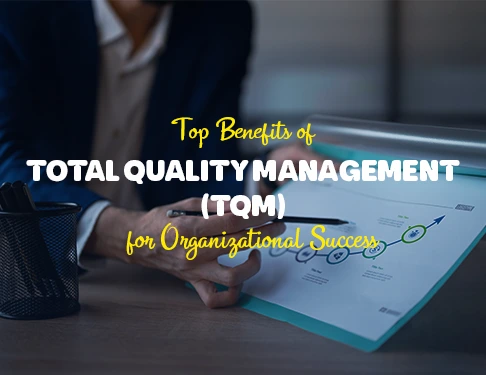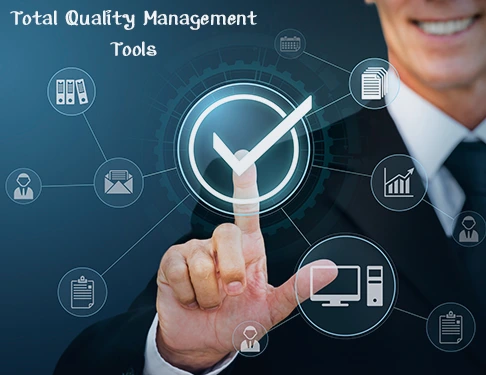Benefits of Implementing Total Quality Management (TQM)
Total Quality Management (TQM) is a business philosophy that prioritizes quality in every aspect of an organization. TQM is more than just a set of practices....
By AMREP | Posted on April 16, 2025

Total Quality Management (TQM) is a mindset that involves everyone in the organization working toward a common goal: achieving excellence through quality. From leadership and strategy to everyday tasks on the ground, TQM integrates quality into every layer of a business.
In this blog, we’ll explore the core principles of TQM, understand how they shape successful organizations, and discover why adopting these principles can be a game-changer for companies aiming to lead with quality.
TQM is a comprehensive and structured approach to organizational management that seeks to improve the quality of products and services through ongoing refinements in response to continuous feedback.
Total Quality Management, or TQM, is a continuous process. It focuses on improving quality at every level of an organization. TQM involves every employee and all departments. The goal is to meet or exceed customer expectations consistently.
Here are the key principles that guide Total Quality Management:

Customers define quality. Every business depends on its customers. So, their needs and expectations must come first. TQM encourages companies to understand their customers deeply. Feedback should be gathered regularly and used to improve products and services.
Everyone must be involved in the quality process. TQM empowers employees to take ownership. When employees feel responsible, they perform better. Training and motivation are key. Open communication also plays a big role.
TQM focuses on processes. A process is a series of steps that lead to a result. Improving the process leads to better results. Businesses should map their key processes. Then, they can identify and eliminate inefficiencies.
TQM treats an organization as a whole. All departments and functions must work together. Quality should be a part of every system. Whether it’s production, marketing, or HR—everyone has a role in delivering quality.
TQM is not a one-time effort. It’s an ongoing journey. There is always room for improvement. Businesses should regularly review their processes. Small improvements over time can lead to big gains.
Decisions should rely on data. Guesswork can lead to mistakes. TQM encourages the use of performance metrics. Analyzing facts helps companies understand what’s working and what’s not.
Communication is the glue that holds TQM together. It keeps everyone aligned. Clear, consistent communication helps teams stay informed and focused on shared goals.
Read More: Total Quality Management Tools
A TQM (Total Quality Management) diagram is a visual representation that outlines the structure and flow of business operations or processes. It typically illustrates the various steps involved in a process, making it easier for management to understand how the process functions.
A TQM Diagram helps organizations:
Several tools are used to create TQM diagrams, including:
| Feature | TQM | Six Sigma | ISO 9001 |
|---|---|---|---|
| Focus | Continuous improvement | Reducing process variation | Standardized processes |
| Approach | Holistic, culture-based | Data-driven, project-based | Compliance and auditing |
| Tools | Basic QC tools, PDCA | DMAIC, statistical methods | Quality manuals, audits |
| Certification | No | Yes (belts) | Yes (ISO certification) |
Implementing Total Quality Management (TQM) offers a wide range of benefits that can significantly improve an organization's performance, efficiency, and customer satisfaction. Some of the key benefits include:

TQM places the customer at the center of all quality improvement efforts. By constantly listening to customer feedback, identifying their needs, and improving products and services based on this input, organizations can significantly enhance the customer experience. Satisfied customers are more likely to return, make repeat purchases, and recommend the company to others, which boosts customer loyalty and long-term profitability.
Example: A hotel chain using TQM might implement guest feedback systems to improve room cleanliness, customer service, or check-in efficiency—leading to better reviews and repeat business.
By focusing on quality at every stage—from design and production to delivery—TQM helps organizations create more reliable, consistent, and high-performing products or services. Instead of fixing problems after they occur, TQM encourages building quality into the process, minimizing defects and errors.
Example: A manufacturing firm using TQM will regularly inspect and improve its processes, reducing the number of defective items that reach the customer.
TQM encourages organizations to streamline operations by removing unnecessary steps, improving workflow, and reducing bottlenecks. Employees are trained to recognize inefficiencies and suggest improvements, which leads to faster production cycles, better resource utilization, and higher output without compromising quality.
Example: A software development team using TQM might adopt agile methodologies and continuous integration, resulting in faster product releases and fewer bugs.
By preventing errors and reducing the need for rework or repairs, TQM helps lower production and operational costs. It also focuses on optimizing the use of materials, time, and labor, contributing to waste reduction and cost efficiency.
Example: In a manufacturing setup, identifying and eliminating non-value-added activities can lead to major savings in material costs and labor hours.
TQM promotes a culture of empowerment, where employees at all levels are encouraged to take ownership of their work and participate in problem-solving. This involvement increases job satisfaction, team spirit, and a sense of purpose, leading to greater motivation and productivity.
Example: Regular team meetings where employees share ideas for improving quality help build a sense of community and recognition.
TQM fosters a mindset of continuous improvement and openness to change, making organizations more adaptable to market changes and customer needs. This flexibility helps companies respond quickly to competition, technological advances, and evolving customer expectations.
Example: A tech company with a TQM culture might more easily adopt new technologies or shift its business model to stay competitive, thanks to its employees’ readiness for innovation and continuous learning. Read More: 18 benefits of Total Quality Management in 2025
At AMREP, we believe that quality isn’t just a goal—it’s a continuous journey. As a trusted supplier quality management company, we embrace the principles of Total Quality Management to ensure that every process, product, and service we deliver reflects our unwavering commitment to excellence. With a focus on innovation, teamwork, and customer satisfaction, AMREP continues to lead the way in building smarter, more efficient, and quality-driven solutions. Because at AMREP, quality starts at the core.
Contact Us To See What We Can Do
Call Us
Mon - Sat 9.00 - 18.00
Sunday Closed


10 - April 2025
10
April
2025
Total Quality Management (TQM) is a business philosophy that prioritizes quality in every aspect of an organization. TQM is more than just a set of practices....

03 - April 2025
03
April
2025
Total Quality Management (TQM) is a comprehensive approach aimed at improving the quality of products and services. It involves all members of an organization in the process of continuous improvement. TQM....

25 - March 2025
25
March
2025
Quality control in healthcare involves the systematic monitoring and evaluation of healthcare processes to meet established standards and regulatory requirements. Quality control is essential in preventing errors, enhancing treatment outcomes, and optimizing healthcare services....
